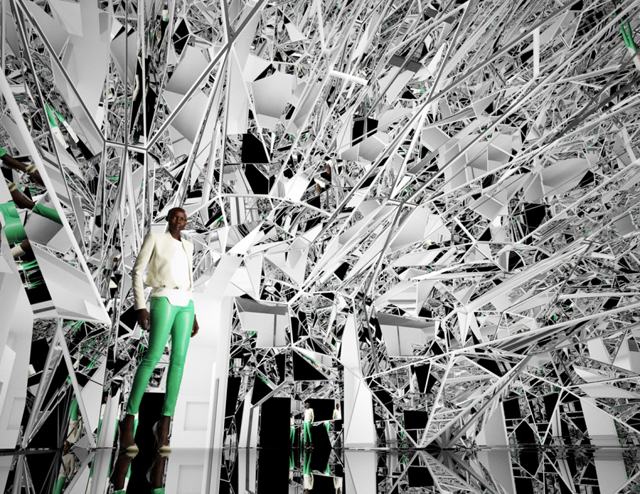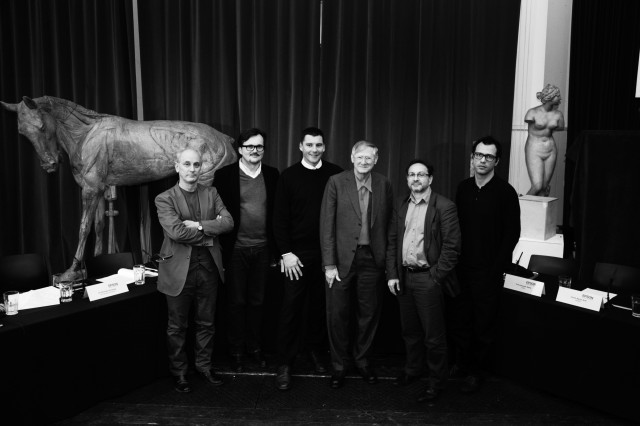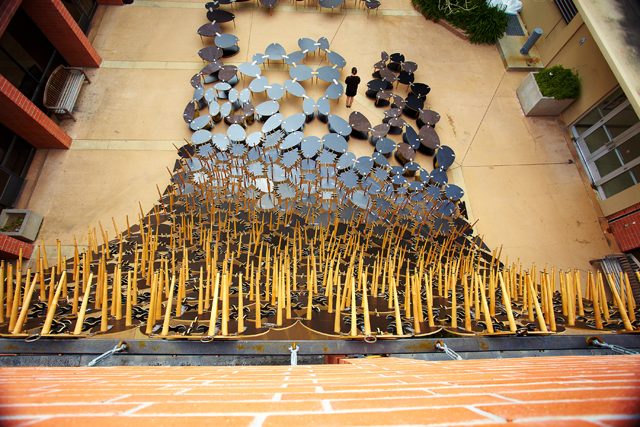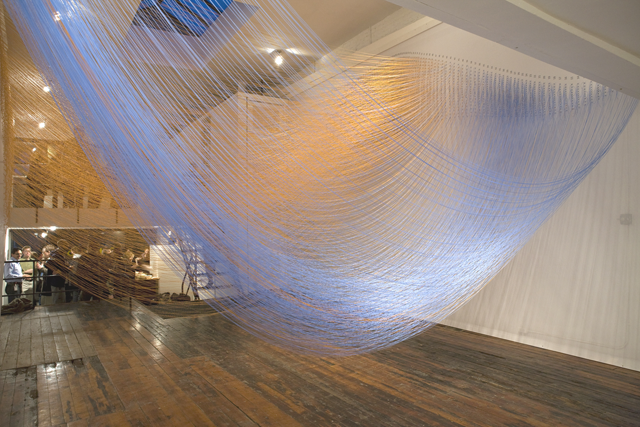BALL + NOGUES | What is decadence for you? The American political process…

An interview with brothers Benjamin Ball by Ilja Burchard.
IB: What is your understanding of temporary architecture/ design, what is enduring for you?
BB: Hmm, well, that is a single question that requires two answers. A lot of people associate us with so-called temporary architecture, although it is not our aspiration to exclusively do that kind of work. We aren’t ideologists about architecture that lasts for a relatively short period. We make projects that are calibrated for a particular place and a particular set of economic and logistical circumstances – one circumstance is time. All physical things are temporary – they are constantly transforming either through accretion or entropy. The paces of these phenomena help determine whether we refer to something as temporary.
We approach the conceptual aspects of projects with lifecycle in mind because a lot of our projects are commissioned to live for only a few months. If that means they are understood as “temporary,” so be it. Several projects with
life spans of less than six months or so have been presented to us in the past several years; we have worked with them. If we had waited for so-called “permanent” projects to drop in our lap seven years ago when we began Ball Nogues, we’d only just be seeing our work first work built.
I see something happening within the culture of architecture reflected in temporary projects. It has to do with dynamics between economic interests. A lot of the people who commission design and architecture now achieve some of the things that architecture used to achieve in terms of identity with a temporary environment rather than a building. “Temporary” entails less commitment for the person who is raising the money and there is often less risk for the designer than a building. Young people without track records are eligible to design these projects and because the blogosphere and digital mediascape lack the hierarchy of print media, a work that costs $1000 can become world-renowned in a few weeks. “Temporary” is in-step with the limits of the contemporary cultural attention span.
However you categorize it, pop-up, installation, retail, event design, these respond to the rapid turnover of ideas in our culture more nimbly than conventional buildings. They can keep pace with the proliferation and circulation of images in the electronic media. The representation of this type of work in the electronic media is both driven by and contributing to the phenomenon.
Installation, a particular subset of “temporary” has become one of the central means for architects to explore and claim intellectual territory prior to establishing a career making buildings. Architects used to create chairs as testing grounds for ideas, now they create installations.
What is enduring for me? Work lives on as a set of ideas and in images, drawings and text but also as memories for me and for the people who experienced the work first hand.
IB: What is a daydream of yours?
BB: Harmony between my personal life and my work so the work comes out of personal values and interests versus me chasing some ideal. If that makes any sense (laughs).
IB: I think you are in a privileged situation as you can do things that you really like to do; so many architects do things or have done things that they do not like
BB: Me too (laughs), I spent a lot of time making things that were less than ideal. but we are not making buildings. That is not to say we won’t make them, but perhaps we never will. Either way, I want this to be a choice. I like very much what we are doing.
IB: What is poetry for you? Explain to me
BB: That isn’t easy to answer, poetry is intangible; I can’t establish a formula or theory for poetry. We look for poetry early in the development of a project, and if we find it, we nurture it as the project evolves. It often entails a kind of harmony between the methods of production, a conceptual angle on the work and visual esthetics . . . but even if all that is present in the project, it doesn’t mean the work is poetic.
Could I define poetry in any clear terms? No.
I think, by definition, it is something that is illusive and very clear at the same time. With respect to what we do, it is appropriate for a particular moment a particular place and a particular time.
IB: What is your next upcoming big project?
BB: It is a permanent installation within the new Bradley West International Terminal at Los Angeles International Airport. We will also be completing, this week, an artwork in Edmonton, Alberta. Gaston is up there installing it right now.
IB: Can you explain a little bit?
BB: That project in Edmonton is called Talus Dome; it is near the banks of the North Saskatchewan River next to a freeway bridge that crosses the River. It is a sort of synthetic earthwork crossed with a post digital, space-aged architectural pavilion. It was constructed with approximately one thousand mirrored stainless steel spheres assembled to assume a shape that is a cross between a pile of gravel or sand and a parabolic dome.
IB: In what scale is the artwork?
BB: We sized it so it can be “photographed” by people in cars speeding past along the freeway. It is large enough to suggest a full scaled geological feature in the Alberta landscape or perhaps a remnant of human activity such as a pile of gravel or construction debris. It is about 11 meters at its base and about 9 meters tall.
IB: What inspires you/what methods of inspiration do you use?
BB: A central concern in our work is the planning of production methods; the design of the factory before the design of the object. Craftsmanship inspires us. We study the making of things in industries ranging from automotive to fishing nets, to guns, to macramé, you name it. We watch fabrication and craft demonstration videos on YouTube; they inspire us to think about how different manufacturing processes can be applied at an architectural scale. So, our initial inspiration often is not directly related to design, architecture or art. We start with a premise about production and then go about designing of our own way making things.
IB: So more or less like ordinary people?
BB: If by ordinary you mean non-designers and non-artists, then yes. In general, we are looking at craft. It is interesting to see fabrication experiments posted on YouTube. Like a guy inflating a steel pillow (hydro-forming) with high-pressure water… the videos demystifies what otherwise might seem to be an elaborate production method when in fact it is actually accessible to us and can be performed in our studio (laughs).
IB: Sounds like fun!
BB: Oh yes, very much. Backyard videos are just an example; there is so much visual information available on the web about craft, manufacturing and fabrication today.
Twenty years ago it would have been very difficult to learn about hydro forming without visiting a manufacturing facility, now I can look up the topic on YouTube and watch 50 demonstration videos. This aspect of communication is dramatically transforming architecture and design and is often overlooked in the discourse. A lot of the discussion is focused on the software tools, the computational approach but I think the exchange of knowledge about craft knowledge through videos is a transformative factor in design culture.
IB: How is Janet Jackson?
BB: I don’t know… she is probably embroiled in a lawsuit, fighting over the Michael Jackson estate (laughs)!
IB: How was it with her in making the music video?
BB: Oh! It was interesting! That was a long time ago!
I was working for Virginia Lee, who was the production designer for the video. Mark Romanek, the director is very demanding, but as fuel for our creative process he gave us these elliptical instructions about the set he expected us to create. He asked us to imagine apartheid era South Africa in the late1960’s, and a party happening within an abandoned public works building that had been designed by a western colonial modernist architect who had a big ego but wasn’t very talented. (laughs) Those were great instructions! So to frame the design exploration, we came up with some terms to describe what we were after. We called it “modern, decorative, ecumenical banality”; these words gave us guidelines for developing the design.
IB: Sounds like fun!
IB: You have also made the set design for Audi, today this would be made on computers, no?
BB: Well, they still build sets for commercials and films but sets are often a hybrid between virtual and physical environments. They might physically construct certain elements of the environment for a given scene and then put a green screen behind them and link them to a digital environment; they would then put together the physical and digital into a single moving image. There are a lot of ways one could make that Audi commercial today.
IB: So, do you think that computers can change fantasy, the aspects of fantasy?
BB: You mean does it change how people imagine the world?
IB: Yes!
BB: Absolutely! Without question, because this technology is us, and we are part of technology: we are enmeshed in an evolving ecosystem of which technology is a part. So offcourse there is a transformation! We live in a culture where information technology is like the air we breathe; we can’t escape it. So, whether one sees it or not, digital technology impacts the contemporary imagination, it has to.
Related Posts :
Category: Article
Views: 2878 Likes: 0
Tags: benjamin ball , Gaston Nogues , Ilja Burchard , interview , project
Comments:
Info:
Info:
Title: BALL + NOGUES | What is decadence for you? The American political process…
Time: 15 marzo 2012
Category: Article
Views: 2878 Likes: 0
Tags: benjamin ball , Gaston Nogues , Ilja Burchard , interview , project









